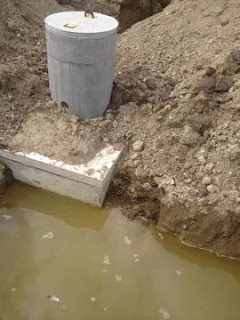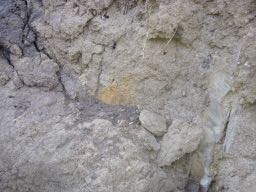A Trilogy of Failure for this Septic System
As a full service septic treatment company,
working many of the municipal districts in southern Alberta, we run into a
number of failed systems every year and are contracted to determine why the
system failed. We have the expertise and equipment to get to the bottom of most
failures.
One of the most interesting ones, in the last
few years, was one that had failure at three levels. The design team, the
installation team and the regulatory team. To some extent, it demonstrates the weaknesses
in the Alberta protocol for designing, installing and inspecting septic
treatment systems.
I would suggest that the main weakness is
lack of training and verification of training by proper testing of the
applicants for both the Certificate of Competency and the testing for a SCO designation.
This shows up in the installers and inspectors not taking the design and
installation of septic treatment facilities in Alberta seriously enough.
The thought still seems to be “disposal” when it should be "treatment”. Just because we don’t see effluent on the surface does not mean the septic system is properly treating the effluent before it reenters the ground water.
The thought still seems to be “disposal” when it should be "treatment”. Just because we don’t see effluent on the surface does not mean the septic system is properly treating the effluent before it reenters the ground water.
But one of the most concerning issues in
this case is something we are seeing over and over again. Engineers that do not
have the proper qualifications, are being contracted
to provide design documents and/or oversight and review opinions.
to provide design documents and/or oversight and review opinions.
Some counties require professional
involvement for subdivision applications and some hire consultants to review
subdivision applications.
Unfortunately, it has been our experience
that many of these engineering professionals are not really knowledgeable in
the requirements of septic design and have never taken either the training
required by Municipal Affairs for a Certificate of Competency or other training, to develop an understanding of how wastewater needs to be treated. Many are not
even involved in a soils sciences discipline.
Some of these engineers simply do a quick
scan through the SoP and then consider themselves “experts” on septic matters.
Others hire Certified Installers to do some of the field work for them.
Unfortunately, many of the installers in
the industry are not truly qualified to do soils investigation. This is
something that our Chief Inspector at Municipal Affairs, Mr. Dean Morin, P. Eng.,
is starting to address seriously. It is our hope that APEGA will also start
addressing the qualifications of their members when it comes to involvement in
the septic industry.
Back to this specific septic installation. In
this case, we had the advantage of watching the disaster unfold as we were
working on an adjacent property.
On the site in question, when the excavator
dug in the water line between the house and the well, it filled with more than
two feet of water. When the septic tank was installed, it flooded to within 12
inches of the top.
Yet the installer proceeded to dig out a conventional trench
system (except that he used a five-foot bucket when only three foot wide trenches
are permitted.) The trench bottoms at two feet deep revealed large mottles two
to four inches in size. There was no evidence of any test pits being dug.
There is absolutely no excuse for the installer to proceed with a system that involved primary treated sewage and a conventional tile and stone field when he knew that the tank hole and the well trench had water in them.
 |
What could possibly be wrong with this? |
There is absolutely no excuse for the installer to proceed with a system that involved primary treated sewage and a conventional tile and stone field when he knew that the tank hole and the well trench had water in them.
When the situation was referred to the
local inspector, the excavator came back and dug some test pits and commenced
to collect some soil samples. When large gleys and mottles were pointed out, it
was clear the excavator had no knowledge of their significance but at least he
was smart enough to then call in a professional soil surveyor.
The soil survey company that responded is
lead by professional engineer. The individual doing the survey was told about
the high water conditions and we assumed that there would be a proper
resolution of the issues. We were a little surprised that, shortly after we completed
our job next door, the chambers were installed in the original ditches and the
job was completed.
Life happens.
The next spring we were contacted by the
new purchaser of the property to final grade the site, prep and seed it to
grass. As some of the “inspection” ports were not visible and we did not want
to damage any that may be buried, we asked the owner to contact the County for
the design info submitted for the septic permit application.
The first info that came back to us was a
diagram that substantially matched the layout. A single test pit soils
inventory sheet, which was missing the soils texture info, was identified as
the correct owner but was dated seven
years previous. Soil structure did not match the site soils. Also included
was a tank manufacturers calculation sheet and it was dated three years
previous. The county involved should never have taken in this application when the dates showed that the designer was simply reusing an old application, changing the name and not doing the appropriate work for this application. The applicant signs that the he believes that the information is substantially correct so in using this old information, he is basically committing fraud!
When these discrepancies were pointed out
to County, we were informed that those sheets were misfiled and a new report
was sent to us. The new application material showed an updated plot plan
showing about forty percent more field, a new calculation sheet to sustain the
larger area and an Engineer’s letter stating that the soils contained no
limiting factors or ground water.
The engineer then goes on to take the soil
loading rates from the two test pits (“moderate” loam soils and “moderate”
sandy loam soils and averages them for a loading rate of .32 gallons per day.
However the engineer also included two standard soil profile sheets for the two
test pits. Test pit one list soils horizons from “A” to “E”. (We know that the
Canada System for Soils Classification only recognizes horizons “A” to “C” in
mineral soils). Horizon C is 22-46 and D is 46 to 240 cm. Both display “few”
mottles
and D is indicated as “very moist, wet pockets.” D horizon also shows
“faint gleying.” Test pit two shows similar results. It is clear from this information that the Engineer does not understand soils and septic treatment, yet he set his seal to the documents. This is against APEGA regulations.
 |
Mottles in the sand lense, a sure sign of seasonal saturation |
 |
Water in bottom of test pit. Note fine mottles on the side wall and active water seepage.
|
Included with the second package is a
letter from the inspector noting “PSDP, cement tank, field. Also a PSDS Permit
Services Report indicating that the inspection company “has provided compliance monitoring services
as required by the Safety Codes Act and Codes etc. It is their opinion that “the
work complies with the intent of the Safety Codes Act and applicable
regulations.”
As the system does not meet the requirements of the the SoP, the inspector should have failed the system.
As the system does not meet the requirements of the the SoP, the inspector should have failed the system.
So, in this case we see the failure of the
design team, the failure of the AHJ and the failure of the contracted
inspections team all contributed to the possibility of ground water contamination. For those who want to get at the nitty gritty, I have
attached a “sanitized” version of my report.
It is important that all individuals
involved in septic treatment understand their responsibilities. But it is extremely important that Engineers who are involved in either design, overview or peer reviews, actually
have the expertise required to do that work.
Purchasers and banks rely on their opinion when doing their due diligence and when they see an engineer’s seal, they assume the information is provided by a professional with a good knowledge of the area they are practicing in.
Purchasers and banks rely on their opinion when doing their due diligence and when they see an engineer’s seal, they assume the information is provided by a professional with a good knowledge of the area they are practicing in.
No comments:
Post a Comment